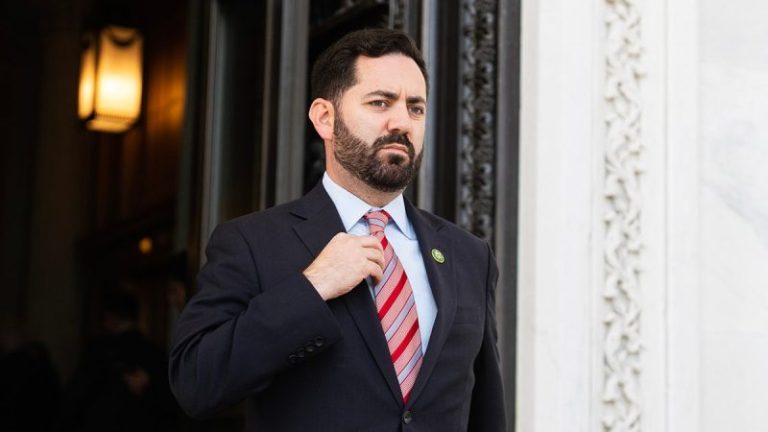The so-called ‘Biden effect’ appears to be a factor in congressional longevity after Senate Minority Whip Dick Durbin announced he would not seek re-election after nearly four decades in Congress.
In 2024, President Joe Biden was politically pushed out after a disastrous debate performance against President Donald Trump in favor of his decades-younger deputy, Kamala Harris.
Since then, several senators – mostly Democrats – and many above private-sector retirement age, have announced their retirement.
‘This is fallout from the ‘Biden Effect,” said Rutgers University political scientist Ross Baker. ‘It contaminated old Democrats.’
Durbin, 80, Sens. Jeanne Shaheen, D-N.H., 78, Tina Smith, D-Wis., 67, Gary Peters, D-Mich., 66, as well as Mitch McConnell, R-Ky., 83, all announced their exit in 2025.
Prior to Biden’s infamous debate, several 2024-cycle Democrats – now-former Sens. Benjamin Cardin of Maryland, 81, Tom Carper of Delaware, 78, Debbie Stabenow of Michigan, 74, and Democrat-turned-independent Joe Manchin of West Virginia, 77 – all declared their exits.
Durbin’s seat has already been targeted by up-and-coming Illinois Lt. Gov. Juliana Stratton, 20 years his junior – who announced a bid shortly after he announced his retirement.
Of the members still seated in Congress, Senate Minority Leader Chuck Schumer, D-N.Y., 74, is potentially facing a heated primary in 2028 from the likes of progressive star Rep. Alexandria Ocasio-Cortez, 35.
After Schumer faced intense backlash from his own party for ultimately supporting the GOP’s government funding bill earlier this month, Ocasio-Cortez’s name returned to the discussion as a young upstart potentially taking out the old guard.
Schumer saw his worst polling within the Empire State in 20 years, according to a Siena College survey, with the Brooklynite 10 points underwater following the funding bill debacle.
Meanwhile, Ocasio-Cortez’s favorables are 47-33 in New York, up about 10 points from 2021.
A renewed push for older Democrats to pass the torch came when DNC vice chair David Hogg launched a project to recruit and bankroll primary opponents for older Democratic incumbents.
‘Today’s party politics has an unwritten rule – if you win a seat, it’s yours for life. No one serious in your party will challenge you. That is a culture that we have to break,’ Hogg, 25, wrote on his political website, Leaders We Deserve.
The oldest member of Congress – Sen. Chuck Grassley, R-Iowa, at 91 – is the rare example of a lawmaker who has not been in the retirement discussion due to the ‘Biden effect’ or any other phenomenon.
On the left, the same appeared to be true for Sen. Bernie Sanders, I-Vt., who – though older than Biden – was contrasted with him on an energy and cognitive level throughout the campaign season.
Sanders has signaled he may seek to serve a fourth term in 2030, when he will be 89, according to the Burlington Free Press. ‘Friends of Bernie Sanders’ has already been listed on a Federal Election Commission filing for the 2030 sweeps.
McConnell, the former Republican leader, has stepped aside from leadership and was replaced by Sen. John Thune, R-S.D., nearly 20 years younger.
During a 2024 press availability, McConnell appeared to freeze up while speaking, though staffers later suggested he was fine. He has also announced his retirement after 40 years in the Senate.
Rep. Andy Barr, 51, and former Kentucky Attorney General Daniel Cameron, 39, jumped into the fray to succeed the octogenarian Republican.
Of the oldest sitting senators not yet mentioned, Sen. James Risch, R-Idaho, will be 82 by his 2026 potential re-election bid. Fox News Digital reached out for comment from the Gem State senator.
On the flip side, even some of the youngest Senate Democrats are seeing their re-election prospects heavily challenged.
Sen. Jon Ossoff, D-Ga., is facing potential Republican challengers in what is now a swing state.
While none have declared their candidacy, Rep. Marjorie Taylor Greene – who would have the stated backing of President Donald Trump – as well as Rep. Earl ‘Buddy’ Carter and Gov. Brian Kemp are all said to be formidable potential rivals, according to several reports.
Fox News Digital reached out to a representative for Biden for comment on the moniker ‘the Biden effect.’
Fox News’ Paul Steinhauser and Chad Pergram contributed to this report.










